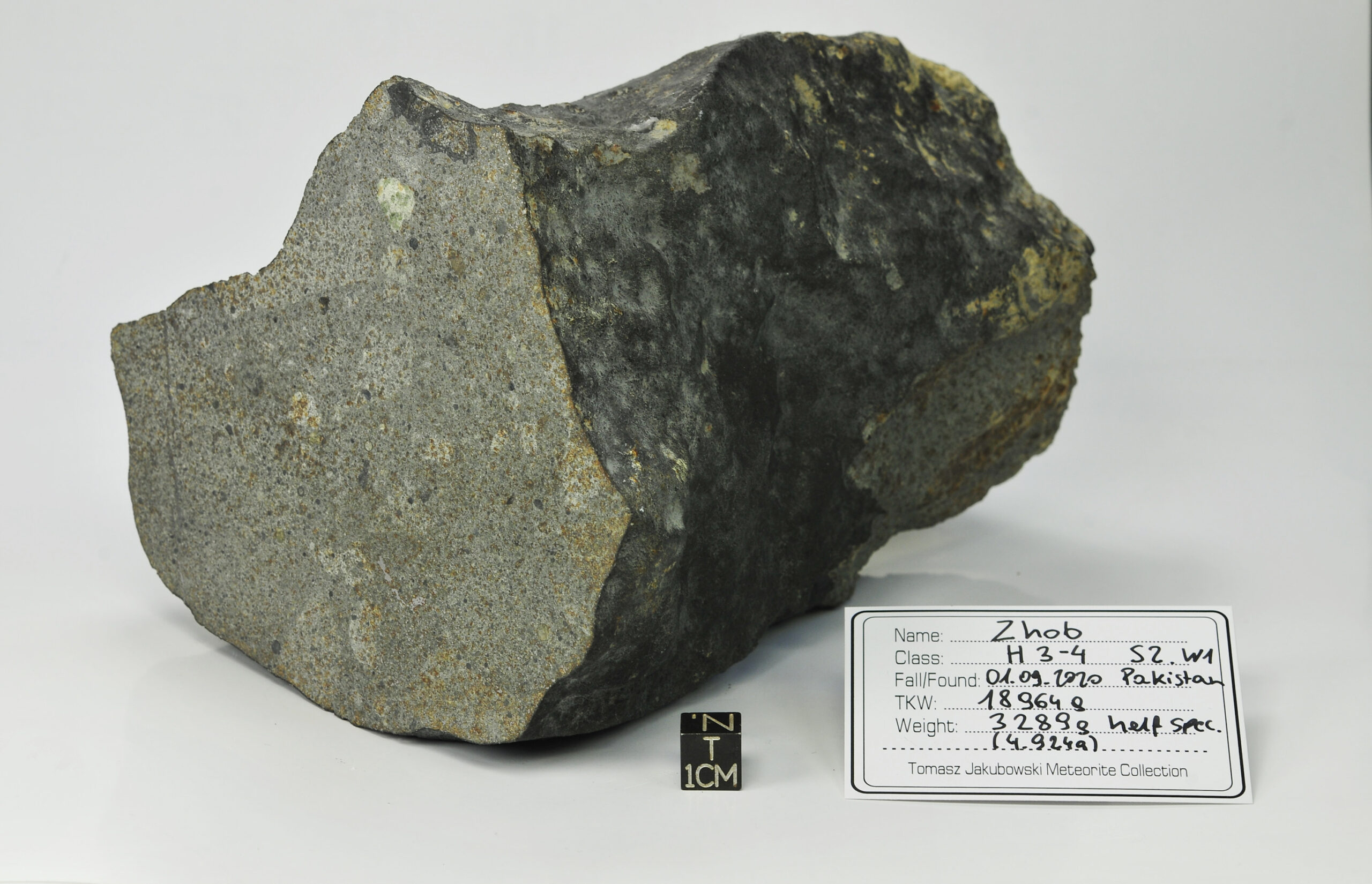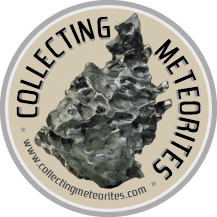
| Price 6€/g |
This is a Museum Quality half specimen from a 4924g piece (listed in MetBull). Here a vido form a find.
Zhob 31°22’N, 69°34’E
Baluchistan, Pakistan
Confirmed fall: 2020 Jan 9
Classification: Ordinary chondrite (H3-4)
History: (M. Farmer, Arizona) A bright fireball followed by sonic booms was seen and heard around the northern part of the Baluchistan province of Pakistan, approximately 6:30 pm local time on 9 January 2020. Shortly thereafter, a stone fell through a house in a local village of the Mando Khel tribal area ~12 km NE of Zhob, Zhob District, Baluchistan province, Pakistan. The largest stone was found shortly after the fall by goat herders. Two more stones were subsequently found in this area.
Physical characteristics: To date, four fusion-crusted stones have been found: 6.309, ~5.5, 4.924, and 2.231 kg. The stones are blocky to rounded, with broad shallow regmaglypts, and covered with black matte fusion crust. The 6.309 kg stone is broken, exposing ~15 × 9 cm of the interior, which displays a breccia of rounded to sub-rounded, light-colored clasts in a light-gray matrix. The clasts range from 1 cm to 5 × 4 cm. The stone is easy to break and weakly consolidated. The measured density of a 24 g fragment that contains both the lithologies is 3.18 g/cm3.
Petrography: (L. Garvie, ASU) The exposed surface of the 6.309 kg stone has an earthy luster, with scattered small (<1 mm) chondrules and rare troilite fragments to 4 mm. No shock veins are visible. Two polished mounts were examined from the gray matrix and a large light-colored clast, respectively. Gray matrix: Section dominated by chondrules and chondrule fragments set in a fine-grained fragmental matrix. Chondrules abundant and clearly visible under a petrographic microscope and BSE imaging, with an apparent mean diameter of 460 µm (n=36). Some PO and PP chondrules show phenocrysts with clear zoning. A PO and BO chondrule contains transparent purple glass. Fe-Ni metal dominated by two grain types: the first is irregularly shaped, with holly-leaf-shaped outlines, to 200 µm grains of kamacite that are single crystals exhibiting weakly developed Neumann bands; the second are rounded grains up to 150 µm, with thin taenite rims enclosing cores of dark-etching plessite. Native copper is rare occurring as grains to 20 µm between Fe-Ni metals and troilite. Troilite grains to 150 µm are largely single crystals and lack shock lamellae. Chromite is a common accessory mineral, occurring as anhedral grains to 200 µm and as fine-grained chondrule-like aggregates to 300 mm. Light-colored clast: The petrography and chondrule size in this clast is similar to the gray matrix section, but differs in showing a coarser grained matrix with abundant feldspathic phase up to 20 µm, and lacking chondrules with zoned olivine or pyroxene-bearing phenocrysts.
Geochemistry: (A. Wittmann, L. Garvie, ASU) Gray matrix – Olivine (n=23) Fa17.2±6.6, range Fa0.7-34.3, Cr2O3 to 1.2 wt% and CaO to 0.5 wt%. FeO/MnO = 38.6±7.9. Low-Ca pyroxene (n=20) Fs13.8±5.3Wo1.3±1.1, FeO/MnO = 25.1±10.3. High-Ca pyroxene (n=2) Fs1.1Ca45.9 and Fs24.2Ca30.5. Light-colored clast – Olivine (n=14) Fa18.5±0.24, range Fa17.9-18.8, FeO/MnO = 37.8. Low-Ca pyroxene (n=17) Fs15.3±0.3Wo1.3±0.1, FeO/MnO = 23.4. Kamacite: Ni 6.71-7.08 wt%, Co 0.44-0.48 wt%. Feldspathic phase (stoichiometry is poor, FeO is fairly high): Ab81.4-83.1An10.7-12.6Or4.3-6.5 (n=10).
Classification: H3-4. Breccia of H4 clasts in an unequilibrated H3 host matrix. W0 and S2.
Specimens: The 6.309 and 2.231 kg stones are with MFarmer.
